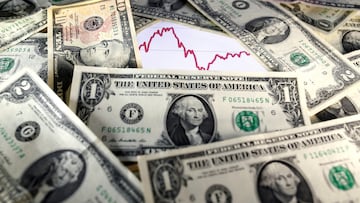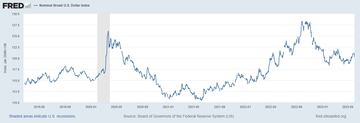What does a strong dollar mean for the US Economy? How long will it last?
The US dollar is defying the odds short sellers have placed on it, remaining strong longer than expected as the US economy powers on despite Fed rate hikes.

The US dollar has been enjoying a longer than expected period of strength despite predictions that it would be in decline. The Greenback is currently around 15% above its post-pandemic low buoyed by the Fed’s ratcheting up of interest rates and month-after-month of strong economic data in spite of the increased cost of borrowing.
However, those investors that are bearish believe that the US central bank will end its policy of jacking up interest rates while other policymakers continue to do so. As well, that the long-predicted slowdown in the US economy will thus change the winds to the disadvantage of the US dollar. But what exactly does a strong dollar mean for the US Economy?
What does a strong dollar mean for the US Economy?
A strong dollar cannot be characterized “as good or bad for the overall economy” according to the Congressional Research Service. Its affects are felt more acutely by different parts of the economy, especially the US trade sector.
On the one hand, it can be good for consumers as it makes imports cheaper and thus, they should have more purchasing power. Likewise, it should reduce inflationary pressures, which hit a four-decade high over the past year, as imported raw materials become cheaper.
However, the flipside of the coin is that a strong dollar hurts US companies that operate internationally. The revenue that they earn in other countries is worth less state side. The elevated dollar has already wiped billions off corporate earnings in lower currency translations. Just as imports get cheaper for Americans, US products get more expensive for foreign consumers, as well as compared to imported products, and thus driving down demand for them.

How long will the strong dollar last?
The US economy has rebounded from the pandemic-induced recession of 2020 at lightening speed, much faster than other economies around the world. That strength has helped drive up the value of the US dollar compared to other currencies. The effect was put into overdrive when the Federal Reserve began to raise interest rates bringing the Greenback to parity and beyond with the euro for the first time after nearly twenty years.
It has since retreated but has experienced a recent rally of sorts jumping 2.5% from its recent low against a basket of currencies. The reversal of fortunes for the US dollar has defied expectations, but bearish investors are biding their time. The full effect of the central bank’s interest rate hikes has yet to fully set in and a slowdown of the US economy is expected.
Should the Fed begin to lower interest rates, while other central banks keep theirs high or even raise them, that would typically put downward pressure on the US dollar, absent other macroeconomic forces. That is because it would make the returns on US Treasuries lower comparatively to bonds of other countries and thus dampen demand for them as investors seek better returns in other markets.
When will the Federal Reserve lower interest rates?
The fast-rising prices after the pandemic due to supply and demand imbalances was a major reason why the Fed began raising rates at the most aggressive pace since the 1980s. After ten consecutive increases, the overnight bank funding rate has gone from near zero to the range of 5.00% to 5.25% since March 2022. Futures investors are betting that policymakers will skip an increase when they meet 13-14 June, but another interest rate hike could be on the way at the Federal Open Market Committee July meeting.
When will the Federal Reserve lower interest rates? That is anyone’s guess. However, debt traders have pretty much priced out the possibility interest rates coming down before yearend. Former Fed Governor Randy Kroszner told Bloomberg that he sees rates staying above 5 percent for longer than many expect and “for sure” could go up to 6 percent.






